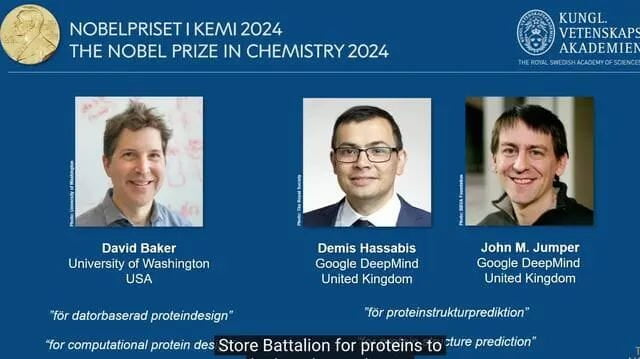On October 9, local time, the Royal Swedish Academy of Sciences announced that it had awarded the 2024 Nobel Prize in Chemistry to David Baker, Demis Hassabis, and John M. Jumper for their contributions to the fields of protein design and protein structure prediction.The three laureates received a total of 11 million SEK in prize money.

A Royal Swedish Academy of Sciences press release issued the same day said the 2024 Nobel Prize in Chemistry is for proteins, the ingenious chemical tools of life.David Baker has succeeded in the near-impossible feat of constructing a whole new class of proteins.Demis Hassabis and John M. Jumper have developed an AI model to solve a 50 year old problem: predicting the complex structure of proteins. These discoveries have enormous potential.
Heiner Rink, Chairman of the Nobel Prize Committee for Chemistry: “One of the discoveries recognized this year has to do with the construction of miraculous proteins. The other discovery has to do with the realization of a 50-year-old dream: the prediction of protein structures based on amino acid sequences. Both discoveries open up vast possibilities.”
They cracked the code to the protein's amazing structure
The 2024 Nobel Prize in Chemistry is all about proteins, the ingenious chemical tools of life. david Baker has accomplished the near-impossible feat of creating entirely new proteins. demis Hassabis and John M. Jumper have developed an artificial intelligence model to solve a 50-year-old problem: predicting the complex structure of proteins. These discoveries hold great potential.
One of the discoveries recognized this year was about the construction of amazing proteins. Another was about the realization of a 50-year dream: the prediction of protein structure from amino acid sequences.
Heiner Kling, chairman of the Nobel Committee for Chemistry, said both discoveries opened up enormous possibilities. Proteins are usually made up of 20 different amino acids that can be described as the building blocks of life. In 2003, David Baker succeeded in using these modules to design a new protein unlike any other. Since then, his research group has created one imaginative protein after another, including proteins that could be used as drugs, vaccines, nanomaterials and microsensors.
The second finding concerns the prediction of protein structure. In proteins, amino acids are linked together in long strings that fold up to form a three-dimensional structure, which is decisive for the function of the protein. Since the 1970s, researchers have tried to predict protein structures from amino acid sequences, but this is known to be very difficult. However, four years ago, there was an amazing breakthrough.In 2020, Demis Hassabis and John M. Jumper demonstrated an artificial intelligence model called AlphaFold2. With its help, they have been able to predict the structure of almost all of the 200 million proteins that researchers have identified. Since their breakthrough, AlphaFold2 has been used by more than 2 million people from 190 countries. Among countless scientific applications, researchers can now better understand antibiotic resistance and create images of enzymes that can break down plastics. Without proteins, life could not exist. We can now predict protein structures and design our own proteins, which brings the greatest benefit to humanity.

